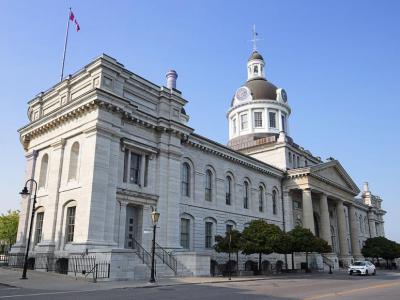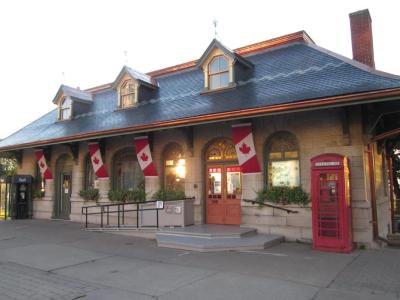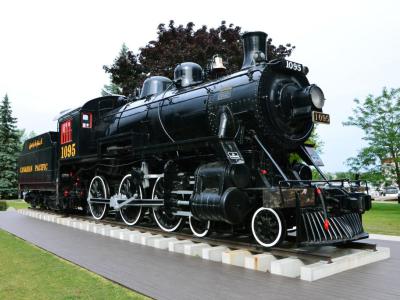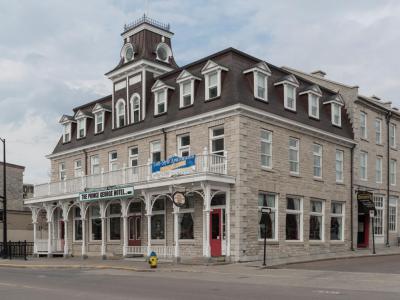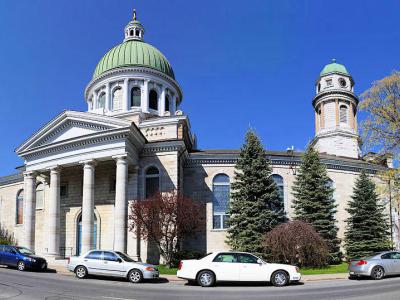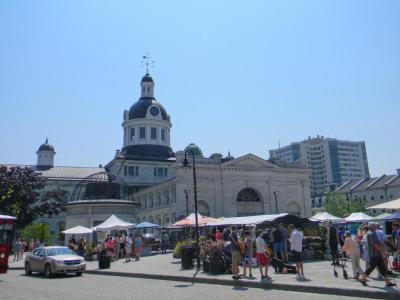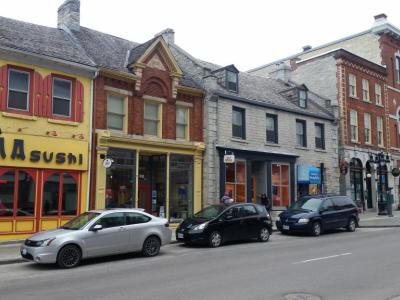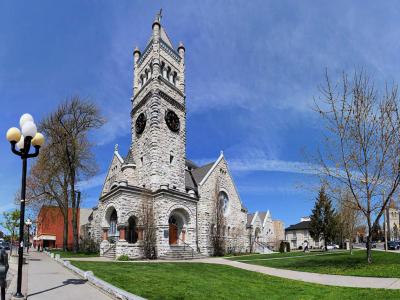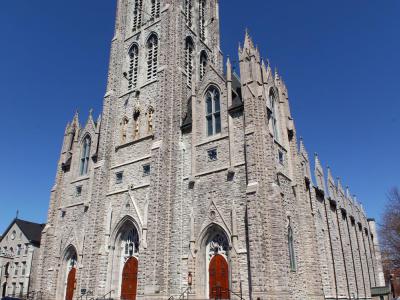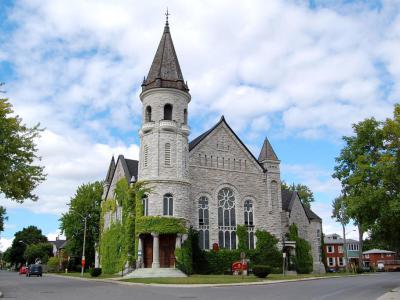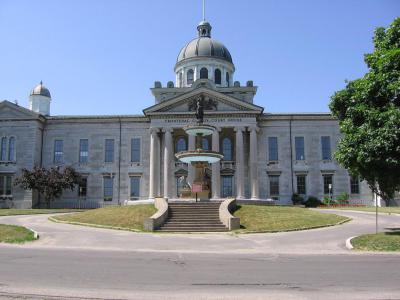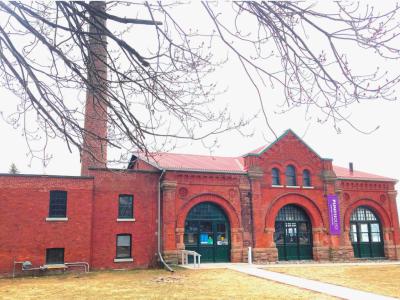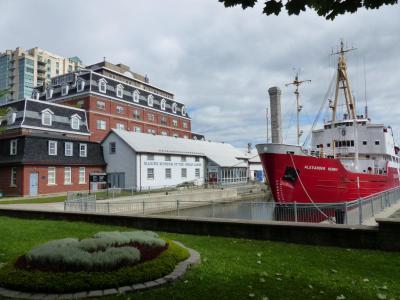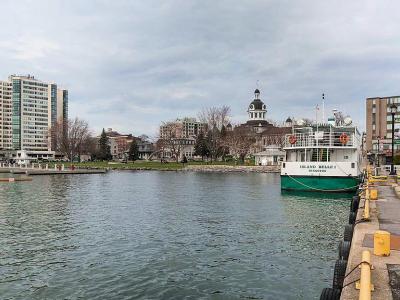Kingston Introduction Walking Tour (Self Guided), Kingston
Kingston, Ontario, known as the "Limestone City" due to its numerous heritage buildings made from local limestone, has a rich history that began with European exploration in the 17th century. The French established a trading post and military fort in 1673 strategically located at the head of the Saint Lawrence River and the mouth of the Cataraqui River that drains into Lake Ontario. This site, essential for controlling trade with local Native groups, was initially called Fort Cataraqui and later Fort Frontenac.
The name Cataraqui itself derives from an Indigenous word, which could mean “Great Meeting Place” or several other interpretations linked to the natural geography of the area, emphasizing its historical significance as a convergence point. After the Conquest of New France by the British, the area was renamed Kingston in 1788, in honor of King George III, and started to attract Loyalist settlers.
Kingston's military importance continued through the War of 1812, with the construction of fortifications and naval defenses, notably during an American naval attack in 1812. By the 19th century, Kingston was named the first capital of the United Province of Canada in 1841, although it was the capital for only a brief period until 1844.
Throughout the 20th century, Kingston shifted from an industrial to an institutional focus, driven by the expansion of educational and healthcare facilities, and underwent significant governance changes that led to the amalgamation forming the modern City of Kingston in 1998.
At the heart of its historic downtown stands the majestic City Hall, built in the 1840s with a Neoclassical design that reflects its time as the epicenter of local governance.
Kingston is also a city of spiritual landmarks with numerous historic churches dotting its landscape. Saint George's Cathedral, a fine mix of Neoclassical and Georgian architecture, and Saint Mary’s Cathedral represent significant chapters in the religious life of the community, each with its own unique stories and architectural beauty.
Kingston's extensive waterfront provides scenic views and recreational opportunities, making it a focal point for both locals and visitors.
Anyone who's a history enthusiast, a lover of architecture, or simply in search of a picturesque place to relax, will find in Kingston a unique blend of all these opportunities waiting to be explored. Visit Kingston to step back in time, enjoy the vibrant cultural scene, and create your own memories in this historic Canadian city.
The name Cataraqui itself derives from an Indigenous word, which could mean “Great Meeting Place” or several other interpretations linked to the natural geography of the area, emphasizing its historical significance as a convergence point. After the Conquest of New France by the British, the area was renamed Kingston in 1788, in honor of King George III, and started to attract Loyalist settlers.
Kingston's military importance continued through the War of 1812, with the construction of fortifications and naval defenses, notably during an American naval attack in 1812. By the 19th century, Kingston was named the first capital of the United Province of Canada in 1841, although it was the capital for only a brief period until 1844.
Throughout the 20th century, Kingston shifted from an industrial to an institutional focus, driven by the expansion of educational and healthcare facilities, and underwent significant governance changes that led to the amalgamation forming the modern City of Kingston in 1998.
At the heart of its historic downtown stands the majestic City Hall, built in the 1840s with a Neoclassical design that reflects its time as the epicenter of local governance.
Kingston is also a city of spiritual landmarks with numerous historic churches dotting its landscape. Saint George's Cathedral, a fine mix of Neoclassical and Georgian architecture, and Saint Mary’s Cathedral represent significant chapters in the religious life of the community, each with its own unique stories and architectural beauty.
Kingston's extensive waterfront provides scenic views and recreational opportunities, making it a focal point for both locals and visitors.
Anyone who's a history enthusiast, a lover of architecture, or simply in search of a picturesque place to relax, will find in Kingston a unique blend of all these opportunities waiting to be explored. Visit Kingston to step back in time, enjoy the vibrant cultural scene, and create your own memories in this historic Canadian city.
How it works: Download the app "GPSmyCity: Walks in 1K+ Cities" from Apple App Store or Google Play Store to your mobile phone or tablet. The app turns your mobile device into a personal tour guide and its built-in GPS navigation functions guide you from one tour stop to next. The app works offline, so no data plan is needed when traveling abroad.
Kingston Introduction Walking Tour Map
Guide Name: Kingston Introduction Walking Tour
Guide Location: Canada » Kingston (See other walking tours in Kingston)
Guide Type: Self-guided Walking Tour (Sightseeing)
# of Attractions: 14
Tour Duration: 2 Hour(s)
Travel Distance: 3.5 Km or 2.2 Miles
Author: DanaOffice
Sight(s) Featured in This Guide:
Guide Location: Canada » Kingston (See other walking tours in Kingston)
Guide Type: Self-guided Walking Tour (Sightseeing)
# of Attractions: 14
Tour Duration: 2 Hour(s)
Travel Distance: 3.5 Km or 2.2 Miles
Author: DanaOffice
Sight(s) Featured in This Guide:
- City Hall
- Kingston and Pembroke Railway Station
- Engine 1095
- Prince George Hotel
- St. George's Cathedral
- Springer Market Square
- Princess Street
- St. Andrew's Presbyterian Church
- St. Mary's Cathedral
- Chalmers United Church
- Frontenac County Courthouse
- Pump House Steam Museum
- Marine Museum of the Great Lakes
- Kingston Waterfront
1) City Hall (must see)
Kingston City Hall, designed by architect George Browne, was commissioned in 1843 to reflect Kingston's status as a provincial capital. Completed in 1844, this imposing structure is one of the most ambitious examples of 19th-century Canadian municipal architecture. Originally, the building served multiple purposes, housing municipal offices, council chambers, the town market, shops, other offices, and a saloon. A significant fire in 1865 destroyed part of the rear wing, yet the building's essential functions and majestic presence remained intact.
Constructed in the Neoclassical style, Kingston City Hall is a prominent landmark in the heart of the historic downtown, facing the waterfront. The building, occupying an entire city block, is made of limestone and features a Classic style with arched windows and a stunning dome. This dome, a striking feature, includes 16 windows and four clocks, each facing a cardinal direction, symbolizing the building's central role in the city.
Inside, Memorial Hall is particularly notable for its 12 exquisite stained glass windows, each dedicated to Canadian soldiers who lost their lives in combat. These windows add a solemn and reverent aspect to the building, merging its civic function with a tribute to national sacrifice. The hall itself is a testament to the artistry and craftsmanship of the period, enhancing the building's historical and cultural significance.
In 1961, Kingston City Hall was designated a national historic site, recognized for its outstanding representation of Neoclassical architecture in Canada. It also stands as a representative example of a combined-function city hall, seamlessly integrating various public services under one roof.
Constructed in the Neoclassical style, Kingston City Hall is a prominent landmark in the heart of the historic downtown, facing the waterfront. The building, occupying an entire city block, is made of limestone and features a Classic style with arched windows and a stunning dome. This dome, a striking feature, includes 16 windows and four clocks, each facing a cardinal direction, symbolizing the building's central role in the city.
Inside, Memorial Hall is particularly notable for its 12 exquisite stained glass windows, each dedicated to Canadian soldiers who lost their lives in combat. These windows add a solemn and reverent aspect to the building, merging its civic function with a tribute to national sacrifice. The hall itself is a testament to the artistry and craftsmanship of the period, enhancing the building's historical and cultural significance.
In 1961, Kingston City Hall was designated a national historic site, recognized for its outstanding representation of Neoclassical architecture in Canada. It also stands as a representative example of a combined-function city hall, seamlessly integrating various public services under one roof.
2) Kingston and Pembroke Railway Station
The Kingston and Pembroke (K&P) Railway Station, now serving as the Tourist Information Office, is steeped in historical significance. Originally, the site between Ontario Street and the waterfront hosted a market in the early 1800s. From 1846 to 1875, this space was dominated by a large stone gun position known as the "Market Battery."
After the battery was dismantled, the area was converted into a park. In 1885, stone from the Market Battery was repurposed to construct the K&P Railway Station, designed by architect William Newlands. The park was subsequently transformed into a bustling railway yard, reflecting the dynamic industrial growth of the era.
The K&P Railway played a crucial role in Kingston's economic development, transporting lumber, iron ore, phosphates, mica, and other natural resources to the city for shipment. This railway station became a vital hub where goods were transferred from trains to ships, facilitating commerce and industry in the region. The station's presence underscored Kingston's strategic importance in connecting various natural resource industries with broader markets.
Today, the K&P Railway Station, as the Tourist Information Office, not only serves as a gateway for visitors exploring Kingston but also as a poignant reminder of the city’s rich historical tapestry.
After the battery was dismantled, the area was converted into a park. In 1885, stone from the Market Battery was repurposed to construct the K&P Railway Station, designed by architect William Newlands. The park was subsequently transformed into a bustling railway yard, reflecting the dynamic industrial growth of the era.
The K&P Railway played a crucial role in Kingston's economic development, transporting lumber, iron ore, phosphates, mica, and other natural resources to the city for shipment. This railway station became a vital hub where goods were transferred from trains to ships, facilitating commerce and industry in the region. The station's presence underscored Kingston's strategic importance in connecting various natural resource industries with broader markets.
Today, the K&P Railway Station, as the Tourist Information Office, not only serves as a gateway for visitors exploring Kingston but also as a poignant reminder of the city’s rich historical tapestry.
3) Engine 1095
Engine 1095, tracing its roots back to 1913, stands as a tangible link to Kingston's industrial past, embodying the legacy of the Canadian Locomotive Company Ltd. (CLC) once situated on the city's waterfront. Initially deployed in Winnipeg and later in Southern Ontario, the locomotive concluded its service in Montreal in 1960. As a relic of 19th-century technology and industry, the preservation of Engine 1095 signifies a crucial era in Kingston and Canadian history, spotlighting the city's role as a significant industrial and political hub.
Restored to its former glory in 2013, exactly a century after its initial construction, Engine 1095 owes its revival to the dedication of 'The 1095 Restoration Volunteer Group.' Originating in 2007, this group presented their findings and concerns about the locomotive's deteriorating condition to Kingston City Council. The survey included an overall assessment of the locomotive, advocating for its restoration and proposing a viable course of action. City staff, following subsequent research, prompted City Council to greenlight the restoration initiative in 2011, culminating in the completion of the project in 2013, aligning with the locomotive's centenary.
Restored to its former glory in 2013, exactly a century after its initial construction, Engine 1095 owes its revival to the dedication of 'The 1095 Restoration Volunteer Group.' Originating in 2007, this group presented their findings and concerns about the locomotive's deteriorating condition to Kingston City Council. The survey included an overall assessment of the locomotive, advocating for its restoration and proposing a viable course of action. City staff, following subsequent research, prompted City Council to greenlight the restoration initiative in 2011, culminating in the completion of the project in 2013, aligning with the locomotive's centenary.
4) Prince George Hotel
The Prince George Hotel traces its origins to 1809. This historic property comprises several limestone commercial buildings unified by a single facade in 1892. The upper part of the main facade is distinguished by its Second Empire style, featuring a mansard roof, a tower with decorative ironwork, and a one-storey verandah with a balcony. Over the years, the building has housed various businesses, including shops, warehouses, saloons, and an inn, which has recently been converted into loft apartments.
Throughout its history, the Prince George Hotel has played a significant role in Kingston's commercial and social life. The building's middle section is a stone house dating back to around 1817, flanked by new stores constructed in 1847. Following a fire in 1848, the buildings were transformed into a hotel. In 1892, architect William Newlands designed the addition of the third floor and the mansard roof, seamlessly blending the three buildings into a cohesive structure. The intricate ironwork on the tower, the copper roof, and the decorative woodwork further enhance its architectural charm.
The Prince George Hotel's rich history and unique aesthetic have made it an attractive location for filmmakers. It served as a backdrop for HBO’s "Vendetta" (1999) and the TV movie "The Feast of All Saints" (2001), both set in 19th-century New Orleans.
Throughout its history, the Prince George Hotel has played a significant role in Kingston's commercial and social life. The building's middle section is a stone house dating back to around 1817, flanked by new stores constructed in 1847. Following a fire in 1848, the buildings were transformed into a hotel. In 1892, architect William Newlands designed the addition of the third floor and the mansard roof, seamlessly blending the three buildings into a cohesive structure. The intricate ironwork on the tower, the copper roof, and the decorative woodwork further enhance its architectural charm.
The Prince George Hotel's rich history and unique aesthetic have made it an attractive location for filmmakers. It served as a backdrop for HBO’s "Vendetta" (1999) and the TV movie "The Feast of All Saints" (2001), both set in 19th-century New Orleans.
5) St. George's Cathedral
Saint George's Cathedral serves as the seat of the Anglican Diocese of Ontario. The original church, a modest wooden structure, was built in 1792. The present building, constructed between 1825 and 1828, is a large and impressive example of early 19th-century ecclesiastical architecture. It earned the status of a cathedral in 1862, reflecting its growing importance within the Anglican community.
The cathedral is distinguished by its architectural grandeur. A large and beautiful dome crowns the structure, providing a striking silhouette against the Kingston skyline. The elegant entrance, adorned with classical columns, invites worshippers and visitors into a space of serenity and reverence. Inside, the cathedral's magnificent interior features intricate details and craftsmanship, with large stained glass windows that are true works of art, casting colorful light into the sacred space.
In addition to its role in religious services, Saint George's Cathedral is renowned for its excellent acoustics. This makes it a popular venue for musical concerts, enhancing its cultural and community role in Kingston. The cathedral's acoustical qualities allow for a rich and immersive auditory experience, making it a favored location for both performers and audiences.
The cathedral is distinguished by its architectural grandeur. A large and beautiful dome crowns the structure, providing a striking silhouette against the Kingston skyline. The elegant entrance, adorned with classical columns, invites worshippers and visitors into a space of serenity and reverence. Inside, the cathedral's magnificent interior features intricate details and craftsmanship, with large stained glass windows that are true works of art, casting colorful light into the sacred space.
In addition to its role in religious services, Saint George's Cathedral is renowned for its excellent acoustics. This makes it a popular venue for musical concerts, enhancing its cultural and community role in Kingston. The cathedral's acoustical qualities allow for a rich and immersive auditory experience, making it a favored location for both performers and audiences.
6) Springer Market Square
Kingston Market Square, also known as Springer Market Square, has a history spanning over 200 years, making it a central hub of trade and commerce in Kingston. Established in 1801, the market's original layout was part of the town plan set out in 1784, with the first market regulations published in 1811. Archaeological investigations conducted in 2002 and 2003, prior to the square's redevelopment in 2004, unearthed rich historical artifacts. Findings included remnants of an early 1800s market surface, merchant wares, the stone foundations of the 1840s City Hall Market wing, massive stone steps, limestone drains, the market weigh house, and water pipes for the horse fountain.
The square has evolved significantly over the centuries, yet its fundamental purpose as a vibrant marketplace remains unchanged. Vendors from the area have long gathered here to sell a variety of goods, providing residents with easy access to fresh produce, meats, baked goods, plants, flowers, craft items, clothing, and antiques.
Springer Market Square continues to thrive, especially on market days during spring, summer, and autumn, when both locals and tourists flock to the square. The market not only offers a wide range of goods but also serves as a lively social space. On non-market days, the square hosts concerts, evening film screenings, and other public events, maintaining its vibrant atmosphere year-round. In winter, the square transforms into a popular ice-skating rink.
Located centrally behind Kingston's City Hall, the market is one of the oldest in the country, attracting thousands of visitors with its rich history and diverse offerings. The square is also home to several bistros, providing a perfect spot for visitors to relax and enjoy the bustling market ambiance.
The square has evolved significantly over the centuries, yet its fundamental purpose as a vibrant marketplace remains unchanged. Vendors from the area have long gathered here to sell a variety of goods, providing residents with easy access to fresh produce, meats, baked goods, plants, flowers, craft items, clothing, and antiques.
Springer Market Square continues to thrive, especially on market days during spring, summer, and autumn, when both locals and tourists flock to the square. The market not only offers a wide range of goods but also serves as a lively social space. On non-market days, the square hosts concerts, evening film screenings, and other public events, maintaining its vibrant atmosphere year-round. In winter, the square transforms into a popular ice-skating rink.
Located centrally behind Kingston's City Hall, the market is one of the oldest in the country, attracting thousands of visitors with its rich history and diverse offerings. The square is also home to several bistros, providing a perfect spot for visitors to relax and enjoy the bustling market ambiance.
7) Princess Street
Princess Street is a major road, renowned for its historical and commercial significance. Serving as the main retail street of downtown Kingston, Princess Street is lined with numerous historic limestone buildings that contribute to the city's rich architectural heritage. Notable structures include Saint Andrew's Presbyterian Church, which was the first meeting place of the Board of Trustees of Queen's College, and the Commercial Mart Building, which has served various roles including an army barracks, a public works building, and a store. The Grand Theatre, another historic site on Princess Street, is the home of the Kingston Symphony and a central venue for performing arts in the city.
Princess Street not only connects different parts of the city but also serves as a vibrant hub of activity, offering a mix of shopping, dining, and entertainment options. The area around the intersection of Princess and Division Streets is colloquially known as "The Hub." This part of Princess Street is especially popular with students due to its numerous bars and nightclubs, making it a lively nightlife destination. The Hub exemplifies the street's dynamic nature, blending Kingston's historical charm with modern urban vibrancy.
Overall, Princess Street is a vital artery in Kingston, embodying the city's historical depth and its contemporary cultural life. Whether it's the preserved historical buildings or the bustling social scenes, Princess Street offers a unique glimpse into Kingston's past and present.
Princess Street not only connects different parts of the city but also serves as a vibrant hub of activity, offering a mix of shopping, dining, and entertainment options. The area around the intersection of Princess and Division Streets is colloquially known as "The Hub." This part of Princess Street is especially popular with students due to its numerous bars and nightclubs, making it a lively nightlife destination. The Hub exemplifies the street's dynamic nature, blending Kingston's historical charm with modern urban vibrancy.
Overall, Princess Street is a vital artery in Kingston, embodying the city's historical depth and its contemporary cultural life. Whether it's the preserved historical buildings or the bustling social scenes, Princess Street offers a unique glimpse into Kingston's past and present.
8) St. Andrew's Presbyterian Church
Saint Andrew's Presbyterian Church's origins date back to 1822, when its first service was held, marking the beginning of its long-standing presence in the community. In 1889, the building underwent significant reconstruction, yet much of its original design was preserved, maintaining the architectural integrity and historical essence of the church.
One of the most striking features of Saint Andrew's is its collection of beautiful stained glass windows. These windows not only add to the aesthetic appeal of the church but also serve as a medium for storytelling and reflection. Among them, the window depicting the biblical story of Saint Andrew is particularly notable. This artwork captures the essence of the church's namesake and adds a layer of spiritual and historical significance to the space.
In addition to the main sanctuary, Saint Andrew's Presbyterian Church includes a small chapel, constructed in 1967. This chapel is a serene space that further enriches the church's architectural and artistic landscape. Within this intimate setting, visitors can admire more stunning stained glass windows, each telling its own story and contributing to the overall beauty and contemplative atmosphere of the chapel.
One of the most striking features of Saint Andrew's is its collection of beautiful stained glass windows. These windows not only add to the aesthetic appeal of the church but also serve as a medium for storytelling and reflection. Among them, the window depicting the biblical story of Saint Andrew is particularly notable. This artwork captures the essence of the church's namesake and adds a layer of spiritual and historical significance to the space.
In addition to the main sanctuary, Saint Andrew's Presbyterian Church includes a small chapel, constructed in 1967. This chapel is a serene space that further enriches the church's architectural and artistic landscape. Within this intimate setting, visitors can admire more stunning stained glass windows, each telling its own story and contributing to the overall beauty and contemplative atmosphere of the chapel.
9) St. Mary's Cathedral (must see)
Saint Mary's Cathedral, formally known as the Cathedral of Saint Mary of the Immaculate Conception, forms a trio of significant churches within a short distance, including Chalmers United Church and Saint Andrew's Presbyterian Church. Saint Mary's is one of Kingston's two cathedrals, the other being the Anglican Saint George's Cathedral on King Street. The architectural vision for Saint Mary's was crafted by James R. Bowes, with construction commencing in 1842 and the cathedral officially opening on October 4, 1848.
In 1889, the cathedral underwent a substantial enlargement designed by Joseph Connolly, enhancing its grandeur and capacity. A striking feature of Saint Mary's Cathedral is its impressive spire, which ascends to a height of 242 feet, making it arguably the tallest structure in Kingston. This towering spire is a notable element of the city's skyline.
Initially, Saint Mary's Cathedral did not feature any stained glass windows. It was only during the renovations led by Archbishop James Vincent Cleary in 1885 that these beautiful windows were added. The stained glass installations contribute significantly to the cathedral's aesthetic and spiritual ambiance, illuminating the interior with vibrant colors and intricate designs that reflect the rich traditions of the Catholic faith.
In 1889, the cathedral underwent a substantial enlargement designed by Joseph Connolly, enhancing its grandeur and capacity. A striking feature of Saint Mary's Cathedral is its impressive spire, which ascends to a height of 242 feet, making it arguably the tallest structure in Kingston. This towering spire is a notable element of the city's skyline.
Initially, Saint Mary's Cathedral did not feature any stained glass windows. It was only during the renovations led by Archbishop James Vincent Cleary in 1885 that these beautiful windows were added. The stained glass installations contribute significantly to the cathedral's aesthetic and spiritual ambiance, illuminating the interior with vibrant colors and intricate designs that reflect the rich traditions of the Catholic faith.
10) Chalmers United Church
Chalmers United Church is a striking example of late 19th-century ecclesiastical architecture. Constructed in 1890, the church was originally established as a Free Presbyterian Church and named in honor of Thomas Chalmers, a notable Scottish theologian and leader in the Free Church of Scotland movement. The church's name and affiliation reflect its roots in the Presbyterian tradition and its commitment to theological principles espoused by Chalmers.
The architectural design of Chalmers United Church is both beautiful and impressive, showcasing features that enhance its aesthetic appeal and historical significance. The building is adorned with distinctive domed windows that allow natural light to illuminate the interior, creating a serene and uplifting atmosphere for worship and reflection. The church's tower is particularly notable for its elegant balconies, which add to the structure's charm and grandeur, making it a prominent landmark in the city's landscape.
In addition to its architectural beauty, Chalmers United Church has played an important role in the community over the years. It has served as a place of worship, community gatherings, and cultural events, fostering a sense of unity and spiritual growth among its congregants and the broader Kingston community. Its proximity to Queen's University also positions it as an accessible place of worship for students, faculty, and staff, contributing to the rich tapestry of religious and cultural life in the area.
The architectural design of Chalmers United Church is both beautiful and impressive, showcasing features that enhance its aesthetic appeal and historical significance. The building is adorned with distinctive domed windows that allow natural light to illuminate the interior, creating a serene and uplifting atmosphere for worship and reflection. The church's tower is particularly notable for its elegant balconies, which add to the structure's charm and grandeur, making it a prominent landmark in the city's landscape.
In addition to its architectural beauty, Chalmers United Church has played an important role in the community over the years. It has served as a place of worship, community gatherings, and cultural events, fostering a sense of unity and spiritual growth among its congregants and the broader Kingston community. Its proximity to Queen's University also positions it as an accessible place of worship for students, faculty, and staff, contributing to the rich tapestry of religious and cultural life in the area.
11) Frontenac County Courthouse
The Frontenac County Courthouse is a distinguished example of Neoclassical architecture designed by Edward Horsey. The building, which opened in 1858, is constructed from limestone and prominently features the Royal coat of arms of the United Kingdom on its front facade. Overlooking City Park and the scenic expanse of Lake Ontario to its south, the courthouse is a significant landmark in the city’s historic landscape.
The Classical Revival style of the courthouse was influenced by George Browne's Neoclassical Kingston City Hall (1842-1844), featuring a three-storey central block with symmetrical two-storey wings ending in pedimented pavilions. In 1874, a major fire necessitated alterations to the original design, which were carried out by architect John Power. One of the most notable additions from this reconstruction is the domed roof tower, which enhances the building’s classical aesthetic and provides a striking focal point.
Above the dome, a lantern with six semi-circular arches and attached columns mirrors the details below, topped with a flagpole. Additionally, cupolas with octagonal drums and ribbed domes were added to the end pavilions during the reconstruction. The courthouse's design also thoughtfully incorporates larger second-storey windows, which provide ample light to the spacious courtroom areas on the original second floor.
Further enhancing its historic charm, a three-tiered fountain was added to the courthouse grounds in 1903. This addition, along with the existing architectural elements, contributes to the courthouse's status as a cherished heritage site. In recognition of its architectural and historical significance, the Frontenac County Courthouse was designated a National Historic Site of Canada in 1980.
The Classical Revival style of the courthouse was influenced by George Browne's Neoclassical Kingston City Hall (1842-1844), featuring a three-storey central block with symmetrical two-storey wings ending in pedimented pavilions. In 1874, a major fire necessitated alterations to the original design, which were carried out by architect John Power. One of the most notable additions from this reconstruction is the domed roof tower, which enhances the building’s classical aesthetic and provides a striking focal point.
Above the dome, a lantern with six semi-circular arches and attached columns mirrors the details below, topped with a flagpole. Additionally, cupolas with octagonal drums and ribbed domes were added to the end pavilions during the reconstruction. The courthouse's design also thoughtfully incorporates larger second-storey windows, which provide ample light to the spacious courtroom areas on the original second floor.
Further enhancing its historic charm, a three-tiered fountain was added to the courthouse grounds in 1903. This addition, along with the existing architectural elements, contributes to the courthouse's status as a cherished heritage site. In recognition of its architectural and historical significance, the Frontenac County Courthouse was designated a National Historic Site of Canada in 1980.
12) Pump House Steam Museum
The Pump House Steam Museum is a captivating site located on the waterfront that offers a glimpse into the Industrial Revolution's impact on the city. Originally designed as a Victorian-style water-pumping station in 1849, the museum now serves as an educational center, showcasing the technological advancements and industrial heritage of the era.
Visitors to the museum can explore a variety of steam engines and intricate miniature models that illustrate the evolution of steam technology. These exhibits highlight the ingenuity and mechanical prowess that characterized the Industrial Revolution. Among the collection, a notable highlight is an engine dating back to 1897, which exemplifies the craftsmanship and engineering skills of the period.
The museum's Victorian architecture adds to its historical charm, transporting visitors back to a time when steam power was a driving force behind industrial progress. The Pump House Steam Museum not only preserves these remarkable machines but also contextualizes their significance within Kingston's development and the broader industrial narrative.
Visitors to the museum can explore a variety of steam engines and intricate miniature models that illustrate the evolution of steam technology. These exhibits highlight the ingenuity and mechanical prowess that characterized the Industrial Revolution. Among the collection, a notable highlight is an engine dating back to 1897, which exemplifies the craftsmanship and engineering skills of the period.
The museum's Victorian architecture adds to its historical charm, transporting visitors back to a time when steam power was a driving force behind industrial progress. The Pump House Steam Museum not only preserves these remarkable machines but also contextualizes their significance within Kingston's development and the broader industrial narrative.
13) Marine Museum of the Great Lakes
The Marine Museum of the Great Lakes is a dedicated institution preserving the rich marine history of the Great Lakes. Established on August 29, 1975, the museum's mission includes the collection, conservation, and display of artifacts related to the region's marine history, shipping, and shipbuilding. Initially housed in the historic Kingston Dry Dock, a facility constructed in 1890 by the Canadian federal government within the local riding of Prime Minister Sir John A. Macdonald, the site itself is a significant part of the museum's narrative.
The dry dock, designated as a National Historic Site of Canada, features a solid limestone building from 1891 that once contained the drydock pumps and engines, a 1915 annex, and a smaller 1938 building, all capped by a distinctive 90-foot square stone chimney.
The museum's seven galleries offer a comprehensive exploration of the Great Lakes' maritime heritage. The temporary gallery hosts rotating exhibits, such as those commemorating the War of 1812 bicentennial. Among the six permanent galleries, the Donald Page gallery delves into various narratives, including the Age of Sail on the Great Lakes, the life of sailors, and the evolution of ship technology. The Eco Gallery addresses contemporary issues such as pollution, water diversion, conservation, invasive species, and sustainable development in relation to the Great Lakes. The Shipwreck Gallery chronicles the transition from wooden shipbuilding to modern "Lakers," providing a poignant look at maritime advances and tragedies.
The museum's significance extends beyond its exhibits. The Kingston Dry Dock, operational since 1892, was once a crucial ship construction and repair facility for the Great Lakes. Its architectural and historical value, highlighted by the towering chimney visible along the downtown waterfront, underscores Kingston's maritime legacy.
The dry dock, designated as a National Historic Site of Canada, features a solid limestone building from 1891 that once contained the drydock pumps and engines, a 1915 annex, and a smaller 1938 building, all capped by a distinctive 90-foot square stone chimney.
The museum's seven galleries offer a comprehensive exploration of the Great Lakes' maritime heritage. The temporary gallery hosts rotating exhibits, such as those commemorating the War of 1812 bicentennial. Among the six permanent galleries, the Donald Page gallery delves into various narratives, including the Age of Sail on the Great Lakes, the life of sailors, and the evolution of ship technology. The Eco Gallery addresses contemporary issues such as pollution, water diversion, conservation, invasive species, and sustainable development in relation to the Great Lakes. The Shipwreck Gallery chronicles the transition from wooden shipbuilding to modern "Lakers," providing a poignant look at maritime advances and tragedies.
The museum's significance extends beyond its exhibits. The Kingston Dry Dock, operational since 1892, was once a crucial ship construction and repair facility for the Great Lakes. Its architectural and historical value, highlighted by the towering chimney visible along the downtown waterfront, underscores Kingston's maritime legacy.
14) Kingston Waterfront (must see)
The Kingston Waterfront, often less frequented during the colder months, springs to life with the arrival of warmer weather, becoming one of Kingston's beloved attractions. Stretching over a generous 8 kilometers, it offers a multitude of possibilities for visitors. You can opt for a bus tour, embark on a boat cruise around the picturesque 1000 Islands, or enjoy a complimentary ride on the Wolfe Island Ferry. However, don't underestimate the simple pleasure of a leisurely stroll along the Waterfront Trail or through Kingston's charming streets, where historic buildings stand as testaments to the city's rich heritage. Afterward, you can unwind at one of the many downtown patios, sipping a refreshing beverage while gazing out over the serene waters.
The Kingston Waterfront serves as a canvas for self-discovery and a hub of entertainment. Whether you seek the thrill of learning to stand-up paddleboard or prefer to bask in the warmth of an evening sunset, this waterfront destination caters to both the young and old, offering numerous breathtaking spots to explore.
For water enthusiasts, the waterfront presents a plethora of opportunities for aquatic sports, from boating and canoeing to kayaking.
Given its captivating views, it comes as no surprise that Kingston's shores are home to prestigious institutions like the Kingston Rowing Club, Yacht Club, and Canadian Olympic-training Regatta. These water sports and events serve as a prized asset to the city, fostering community involvement and engaging everyone from seasoned sailors to newcomers eager to explore this aquatic playground.
The Kingston Waterfront serves as a canvas for self-discovery and a hub of entertainment. Whether you seek the thrill of learning to stand-up paddleboard or prefer to bask in the warmth of an evening sunset, this waterfront destination caters to both the young and old, offering numerous breathtaking spots to explore.
For water enthusiasts, the waterfront presents a plethora of opportunities for aquatic sports, from boating and canoeing to kayaking.
Given its captivating views, it comes as no surprise that Kingston's shores are home to prestigious institutions like the Kingston Rowing Club, Yacht Club, and Canadian Olympic-training Regatta. These water sports and events serve as a prized asset to the city, fostering community involvement and engaging everyone from seasoned sailors to newcomers eager to explore this aquatic playground.
Walking Tours in Kingston, Ontario
Create Your Own Walk in Kingston
Creating your own self-guided walk in Kingston is easy and fun. Choose the city attractions that you want to see and a walk route map will be created just for you. You can even set your hotel as the start point of the walk.
Barriefield Heritage Village and Royal Military College Tour
Barriefield Heritage Village and the Royal Military College (RMC) in Kingston, Ontario, offer rich insights into Canada’s historical and military heritage. Connected to Kingston via a bridge across the lake, the historic Barriefield Village, established in 1814, is one of Ontario's oldest and most picturesque neighborhoods, designated as a heritage conservation district. The charming area... view more
Tour Duration: 2 Hour(s)
Travel Distance: 3.4 Km or 2.1 Miles
Tour Duration: 2 Hour(s)
Travel Distance: 3.4 Km or 2.1 Miles
The Most Popular Cities
/ view all



